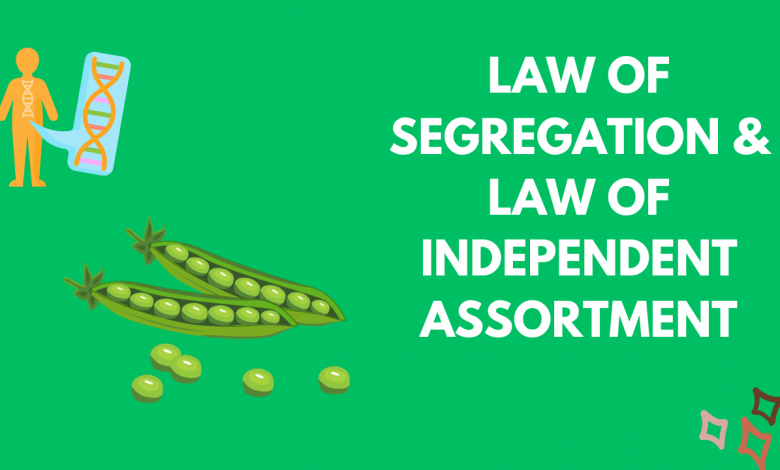Law of Independent Assortment and Law of Segregation – A comprehensive Explanation

The world of genetics is a fascinating realm where the building blocks of life are unlocked, revealing the secrets of heredity and inheritance. Two fundamental principles, the Law of Segregation and the Law of Independent Assortment, play a crucial role in deciphering these mysteries. In this article, we will delve into these laws, demystifying the intricate processes governing the inheritance of traits from one generation to the next.
Table of Contents
The Law of Segregation: Separation of Alleles
The Law of Segregation, proposed by Gregor Mendel in the mid-19th century, is one of the cornerstones of modern genetics. This law deals with the inheritance of single traits, such as eye color or seed shape in plants.
Key Points of the Law of Segregation:
- Alleles: Mendel’s law revolves around the concept of alleles, which are different versions of a gene. For instance, in humans, there are alleles for eye color, with brown and blue being common examples.
- Two Alleles: An organism inherits two alleles for each gene, one from each parent. These alleles can be either homozygous or heterozygous.
- Separation: The two alleles segregate or separate during the formation of gametes (sperm and egg cells). This means that only one allele from each gene passes into a gamete.
- Random Combination: When two gametes fuse during fertilization, they combine randomly, leading to diverse genetic outcomes in offspring.
The Law of Independent Assortment: Genes on Different Chromosomes
The Law of Independent Assortment, also formulated by Mendel, deals with the inheritance of traits located on different chromosomes. Chromosomes are structures in cells that contain genes.
Key Points of the Law of Independent Assortment:
- Multiple Traits: While the Law of Segregation deals with one trait at a time, the Law of Independent Assortment applies when considering two or more traits simultaneously. For instance, when looking at traits like hair color and height in humans.
- Different Chromosomes: Genes that govern different traits are located on separate chromosomes. Humans, for example, have 23 pairs of chromosomes, and genes for different traits are distributed among them.
- Random Arrangement: During the formation of gametes, chromosomes align randomly at the cell’s equator. This random arrangement ensures that maternal and paternal chromosomes for different traits assort independently.
- Variety in Offspring: Law of Independent assortment leads to a greater variety of genetic combinations in offspring, contributing to the diversity seen within species.
Mendel’s Pea Plant Experiments:
To illustrate these laws, Mendel conducted experiments with pea plants. One of his most famous experiments involved crossing pea plants with differing traits, such as flower color (purple or white) and seed shape (round or wrinkled).
In his experiments, Mendel observed that traits segregate independently. This means that the allele for purple flowers could be inherited with either the allele for round seeds or the allele for wrinkled seeds, creating various combinations of traits in the offspring.
Real-World Applications:
Understanding the Laws of Segregation and Independent Assortment has profound implications in various fields:
- Medicine: Knowledge of these laws helps geneticists predict the likelihood of certain traits or diseases in individuals based on their family history.
- Agriculture: Plant breeders use these principles to develop new varieties of crops with desired characteristics, such as disease resistance or higher yield.
- Evolution: These laws play a role in the creation of genetic diversity within species, which is essential for adaptation and evolution over time.
In conclusion, the Law of Segregation governs the inheritance of single traits, while the Law of Independent Assortment applies when considering multiple traits on different chromosomes. These laws, discovered by Gregor Mendel through his pioneering work with pea plants, remain fundamental in the field of genetics, providing insights into the inheritance of traits and the remarkable diversity of life on Earth.
Why Law of Independent Assortment Important?
The Law of Independent Assortment, proposed by Gregor Mendel, is essential in the field of genetics and biology for several critical reasons:
- Understanding Genetic Diversity: The law explains how different traits are inherited independently, leading to the creation of diverse genetic combinations in offspring. This genetic diversity is crucial for the adaptation and evolution of species over time. It allows for the introduction of new traits and the elimination of less favorable ones, contributing to a population’s fitness and survival.
- Plant and Animal Breeding: In agriculture and animal husbandry, the Law of Independent Assortment is applied to create new varieties or breeds with desirable characteristics. Breeders can selectively cross individuals with specific traits, knowing that the inheritance of one trait is not dependent on the inheritance of another. This principle has led to the development of crops with higher yields, disease resistance, and livestock with desired traits.
- Medical Genetics: In human genetics, understanding independent assortment is vital for predicting the likelihood of certain traits or diseases in individuals based on their family history. It allows genetic counselors and medical professionals to assess the inheritance of multiple genes simultaneously, which is essential for diagnosing genetic disorders, conducting pedigree analysis, and providing informed genetic counseling.
- Genetic Research: Independent assortment is a fundamental concept in genetic research. It underlies the principles of genetic mapping, linkage analysis, and genome-wide association studies. Researchers study how genes assort independently to identify genetic markers associated with specific diseases or traits.
- Evolutionary Biology: The law plays a significant role in evolutionary biology. It contributes to the generation of genetic diversity within populations, which is essential for natural selection and adaptation. Genetic diversity allows species to respond to changing environmental conditions and is a driving force behind evolutionary processes.
- Population Genetics: Population geneticists use the Law of Independent Assortment to study the genetic structure of populations. It helps analyze allele frequencies and genetic variation within and among populations, providing insights into evolutionary processes and population dynamics.
- Selective Breeding and Hybridization: The law is instrumental in creating hybrid plants and animals with desirable traits, such as drought resistance in crops or disease resistance in animals. This process has significant implications for food security and sustainable agriculture.
- Biotechnology: In biotechnology and genetic engineering, the principle of independent assortment is critical for the successful manipulation of genes. Scientists can introduce specific genes into organisms, knowing that these genes will segregate independently from the organism’s native genes.
In summary, the Law of Independent Assortment is essential because it elucidates the inheritance patterns of genes located on different chromosomes, leading to genetic diversity, informed breeding practices, medical genetics advancements, and a deeper understanding of evolutionary processes and population genetics. It has far-reaching applications across various scientific disciplines, agriculture, and medicine, making it a foundational concept in genetics and biology.
Why law of independent assortment is not universally applicable?
The Law of Independent Assortment, proposed by Gregor Mendel, describes the inheritance of different genes located on non-homologous chromosomes. According to this law, the alleles (gene variants) of one gene segregate independently from the alleles of another gene during gamete formation, leading to various genetic combinations in offspring. While this law is a fundamental concept in genetics, it is not universally applicable due to certain genetic and biological factors:
- Linked Genes: The law assumes that genes assort independently because they are located on different chromosomes or are far apart on the same chromosome. However, genes that are physically close to each other on the same chromosome tend to be inherited together, violating the principle of independent assortment. This phenomenon is called genetic linkage.
- Crossing Over: During meiosis (the process of gamete formation), homologous chromosomes exchange genetic material through a process called crossing over or recombination. This genetic exchange can break the linkage between alleles of genes on the same chromosome, promoting genetic diversity. However, it also means that genes on the same chromosome may not assort independently when crossing over occurs.
- Exceptions to Independent Assortment: Some genes do follow the Law of Independent Assortment because they are located on different chromosomes. However, many genes are not completely independent due to genetic linkage or other factors. For example, genes located on sex chromosomes (X and Y in humans) do not follow independent assortment because their inheritance depends on the sex of the offspring.
- Complex Traits: The Law of Independent Assortment simplifies genetic inheritance by considering one or a few genes at a time. In reality, many traits are controlled by multiple genes interacting with each other and influenced by environmental factors. This complexity can result in non-Mendelian patterns of inheritance, where genes do not assort independently.
- Epistasis: Epistasis is a genetic phenomenon where the expression of one gene masks or modifies the effects of another gene. In cases of epistasis, the alleles of genes interact, and their inheritance may not adhere to the principles of independent assortment.
- Environmental Influence: Environmental factors can also play a significant role in gene expression and trait development. Genes may interact with the environment in ways that affect their inheritance, making it challenging to predict genetic outcomes solely based on Mendelian genetics.
In summary, while the Law of Independent Assortment provides a foundational understanding of genetic inheritance, it is not universally applicable because genetic linkage, crossing over, exceptions to independent assortment, complex traits, epistasis, and environmental factors can all influence how genes are inherited and expressed. As a result, the inheritance of specific traits or genes may not always follow the principles outlined in Mendel’s law.
Why linked genes violate the law of independent assortment
Linked genes violate the Law of Independent Assortment because they are located on the same chromosome and tend to be inherited together, rather than assorting independently as Mendel’s law suggests. Here’s why linked genes do not follow independent assortment:
- Physical Proximity on Chromosomes: Linked genes are situated close to each other on the same chromosome. During meiosis, the process of gamete formation, homologous chromosomes align and segregate into different daughter cells. Because linked genes are physically close, they are less likely to be separated during this process.
- Crossing Over: While meiosis usually ensures the segregation of genes on different chromosomes (independent assortment), it can also lead to genetic recombination between homologous chromosomes. During crossing over, sections of homologous chromosomes are exchanged, breaking the linkage between alleles. However, when crossing over occurs between linked genes, it can result in new combinations of alleles on the same chromosome rather than the complete separation of alleles onto different chromosomes.
- Inheritance Patterns: When genes are linked, they tend to be inherited together in a manner that reflects their physical arrangement on the chromosome. This means that offspring are more likely to inherit a combination of alleles from one parent, rather than a random assortment of alleles from both parents.
To illustrate this, consider an example involving two genes, A and B, located on the same chromosome. If an individual carries the combination AB on one chromosome and ab on the other chromosome, due to physical linkage, they are more likely to pass on either AB or ab to their offspring, rather than assorting them independently. This can result in non-Mendelian inheritance patterns.
It’s important to note that while linked genes do not follow the Law of Independent Assortment, they can be used to map the relative positions of genes on a chromosome through genetic linkage analysis. By studying how frequently genes are inherited together, scientists can determine the physical distance between genes on a chromosome, providing valuable insights into genetics and gene mapping.
Difference between linkage and Law of independent assortment
Linkage and independent assortment are two contrasting principles that govern the inheritance of genes in organisms. Here are the key differences between linkage and independent assortment:
- Definition:
- Linkage: Linkage refers to the tendency of genes located on the same chromosome to be inherited together because they are physically close to each other.
- Independent Assortment: Independent assortment is a principle that describes how genes located on different chromosomes assort into gametes independently of each other, leading to various combinations of alleles.
- Genes Involved:
- Linkage: Linked genes are those found on the same chromosome.
- Law of Independent Assortment: Law of Independent assortment pertains to genes located on different chromosomes.
- Behavior during Meiosis:
- Linkage: Genes that are closely linked tend to stay together during meiosis, as they are less likely to undergo crossing over and separate into different gametes.
- Independent Assortment: Genes on different chromosomes assort independently during meiosis. They segregate into gametes without regard to the alleles at other gene loci.
- Inheritance Patterns:
- Linkage: Linked genes are usually inherited together, leading to non-Mendelian inheritance patterns where certain allele combinations are more common in offspring.
- Independent Assortment: Genes that assort independently produce a wide variety of allele combinations in offspring, adhering to Mendel’s principles of inheritance.
- Crossing Over:
- Linkage: Linkage reduces the likelihood of crossing over between genes because they are physically close. When crossing over does occur, it can result in recombinant alleles, but linked genes are less likely to recombine.
- Independent Assortment: Crossing over predominantly occurs between non-sister chromatids of homologous chromosomes during meiosis, promoting genetic recombination and the creation of new allele combinations.
- Examples:
- Linkage: An example of linked genes is the ABO blood group system, where the A and B alleles are often inherited together because they are on the same chromosome.
- Independent Assortment: An example of independent assortment is the inheritance of genes for eye color (on one chromosome) and genes for hair color (on another chromosome) in humans.
- Genetic Mapping:
- Linkage: Linked genes can be used for genetic mapping, as the frequency of recombination (crossing over) between them can indicate the distance between gene loci on a chromosome.
- Independent Assortment: Independent assortment is used to explain the variety of traits observed in offspring when considering genes located on different chromosomes.
In summary, linkage involves genes on the same chromosome that tend to be inherited together, while independent assortment involves genes on different chromosomes that assort into gametes independently, creating diverse allele combinations in offspring. These principles play a fundamental role in understanding inheritance patterns and genetic diversity.
Subscribe the Channel to explore the world of Biology



